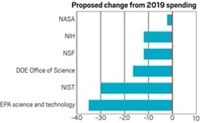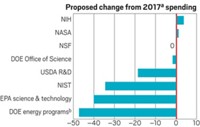Advertisement
Grab your lab coat. Let's get started
Welcome!
Welcome!
Create an account below to get 6 C&EN articles per month, receive newsletters and more - all free.
It seems this is your first time logging in online. Please enter the following information to continue.
As an ACS member you automatically get access to this site. All we need is few more details to create your reading experience.
Not you? Sign in with a different account.
Not you? Sign in with a different account.
ERROR 1
ERROR 1
ERROR 2
ERROR 2
ERROR 2
ERROR 2
ERROR 2
Password and Confirm password must match.
If you have an ACS member number, please enter it here so we can link this account to your membership. (optional)
ERROR 2
ACS values your privacy. By submitting your information, you are gaining access to C&EN and subscribing to our weekly newsletter. We use the information you provide to make your reading experience better, and we will never sell your data to third party members.
Environment
Spending Cuts Set To Kick In
Budget: Federal agencies describe the grim reality they may face on March 1
by C&EN Government & Policy Staff
February 21, 2013
| A version of this story appeared in
Volume 91, Issue 8
Sequester At A Glance
Kick-in date: March 1
Amount to be cut: $85 billion
Annual reduction: Roughly 5% for nondefense programs and 8% for defense programs
Months of fiscal year left to absorb impact: 7
Effective reduction: Roughly 9% for nondefense programs and 13% for defense programs
Federal R&D agencies—like nearly all parts of the government—are bracing for deep budget cuts designed to rein in the nation’s growing budget deficit. The $85 billion in automatic, across-the-board spending cuts, known as sequestration, will result in an approximate 9% cut to nondefense programs for the remainder of fiscal 2013 and a 13% cut for defense programs unless Congress and the White House act before March 1, the date sequestration is slated to kick in.
Effects Of Sequester
NIH: 5.1% reduction for each of the agency’s 27 institutes and centers
NSF: estimated 1,000 fewer research grants
NIST: 100 research associates could be let go
EPA: 1,000 compliance inspections cut
DOE: 25,000 researchers affected by cuts
FDA: 2,100 fewer inspections of domestic and foreign food manufacturing facilities
“If Congress allows this meat-cleaver approach to take place, it will jeopardize our military readiness; it will eviscerate job-creating investments in education and energy and medical research,” said President Barack Obama on Feb. 19.
Federal agencies and the White House are releasing details about how these cuts will affect their operations. By law, the cuts must be equally applied to each program, project, and activity within an account, thereby not allowing agencies to use their discretion.
At the National Institutes of Health, for example, sequestration is expected to cut $1.5 billion of its funding for 2013. The cuts would amount to a 5.1% reduction for each of the agency’s 27 institutes and centers. “That translates into hundreds of grants that would have been funded in this fiscal year that simply won’t get paid,” says NIH Director Francis S. Collins. As a result, several thousand research positions could be eliminated.
Particularly worrisome to Collins are the cuts to NIH training grants for young scientists. “This is not a spigot we turn off and then just turn back on again lightly a year later. If we lose the talents of this up-and-coming generation with all of their dreams and vision, they are not coming back,” he says.
For the Food & Drug Administration, the decreased funding would lead to about 2,100 fewer inspections of domestic and foreign food manufacturing facilities, putting the safety of the U.S. food supply at increased risk. FDA would also face delays in approving new drugs.
At the National Science Foundation, sequestration cuts would affect funding for basic research, new technologies, and science education. Most significantly, the agency estimates it would give out 1,000 fewer research grants in the remainder of 2013, which translates to 12,000 fewer professors, graduate students, teachers, or technicians supported by the agency, according to NSF Director Subra Suresh.
The National Institute of Standards & Technology faces much the same situation, according to Rebecca M. Blank, acting commerce secretary. Cuts would affect grants, equipment purchases, and facilities maintenance. In addition to freezing open positions, 100 NIST research associates could be let go, Blank says. And NIST’s Manufacturing Extension Partnership, which helps small businesses innovate, would be forced to stop some programs.
Weather prediction and preparation will be among the big cuts at the National Oceanic & Atmospheric Administration, Blank says. NOAA expects 1,400 contractors would be let go, 2,700 positions would not be filled, and 2,600 employees would be furloughed.
The Department of Energy faces steep cuts to programs that support basic science R&D, clean energy technology development, nuclear weapons stewardship, and cleanups at former nuclear weapons plants, according to Energy Secretary Steven Chu.
“Thousands of jobs” would be affected, Chu notes in a letter to Senate Appropriations Committee Chairwoman Barbara A. Mikulski (D-Md.), which laid out his view of the expected impact on the department.
The cuts to the DOE Office of Science as well as the 10 national labs it operates would force a reduction of operations, Chu says, affecting some 25,000 researchers. The impact would also include construction delays for lab user facilities and reduced grants and fellowships for researchers working at the labs and at universities.
Also, Chu says, some $900 million would be cut from DOE’s $11 billion annual appropriation for nuclear-weapons-related programs. The reductions, he continues, would affect refurbishment of nuclear weapons as well as U.S. global nuclear weapons nonproliferation programs.
Another large area affected by the sequestration and singled out by Chu is nearly $6 billion spent to clean up and maintain former nuclear weapons manufacturing and development sites. Of particular concern to Chu are the most polluted facilities, which are in Washington, Tennessee, South Carolina, and Idaho. These states, Chu adds, have negotiated and litigated binding cleanup agreements with DOE, and sequestration-driven funding reductions would put milestones in these enforceable environmental agreements at risk.
Sequestration would also limit the Environmental Protection Agency’s ability to use advanced approaches to evaluating chemical hazards, according to the agency. The National Academy of Sciences has recommended that EPA adopt these methods, including high-throughput computerized approaches.
In addition, sequestration would lead to reductions in EPA funding for research on endocrine-disrupting chemicals and would significantly delay ongoing hazard assessments on many of chemicals including styrene, ethylbenzene, and naphthalene. The agency would also reduce the number of graduate and undergraduate fellowships it funds. Two EPA-NIH centers of excellence for children’s health research would stop getting money too.
EPA could cut 1,000 compliance inspections through September if the cuts take effect. The agency would put off planned Superfund cleanups at three to five of the nation’s most polluted hazardous waste sites and stop ongoing work at another site. The agency did not specify which sites would be affected.
And for the Department of Homeland Security’s Science & Technology Directorate, the budget cuts would mean it “would have to stop ongoing research and development including: countermeasures for biothreats, improvements to aviation security and cybersecurity technologies, and projects that support first responders,” says DHS Secretary Janet Napolitano.
The cuts have been a source of political debate since a congressional supercommittee failed to come up with a spending and deficit reduction plan in November 2011. Sequestration was originally set to take effect on Jan. 2, but Congress acted at the last minute to postpone the cuts until March 1.




Join the conversation
Contact the reporter
Submit a Letter to the Editor for publication
Engage with us on Twitter